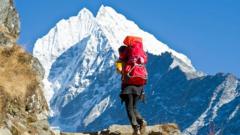Nepal is rolling out a plan to promote tourism in its lesser-known mountain areas by eliminating climbing fees for 97 peaks over the next two years. This initiative is set against the backdrop of rising permit costs for Mount Everest, which will see fees increase to $15,000 (£11,170) from September — the first hike in nearly a decade.
The Nepal Tourism Department aims to draw attention to the country's untapped tourism potential, especially in regions like Karnali and Sudurpaschim provinces, which rank among the poorest and least developed areas in the country. The move is seen as a way not only to boost tourism but also to generate local job opportunities and stimulate the economy. Climbing is a vital part of Nepal's economy, with overall climbing fees yielding $5.9 million last year, predominantly from Everest.
However, the practical implications of this program remain uncertain. Infrastructure in these remote peaks is underdeveloped, which may hinder access for tourists. While local tourism officials express hope that the initiative will lead to increased visitors, historical data shows minimal interest, with only 68 climbers attempting these peaks in the last two years compared to 421 permits issued for Everest just this year.
Additionally, Nepal's Supreme Court has mandated restrictions on the number of climbing permits for Everest to address mounting concerns over overcrowding and safety. For those looking to summit Everest, a new proposal also forces climbers to have successfully scaled a mountain above 7,000m beforehand. Therefore, the subsidization of 97 lesser-known peaks can serve as preparation grounds for aspiring climbers.
In summary, while Nepal's innovative approach may open doors for local economies and enhance overall tourism, the challenges of infrastructure and tourist management will need to be addressed to ensure a sustainable and beneficial outcome for both visitors and local communities.






















